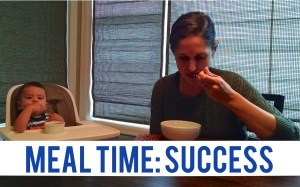I love to eat. Therefore, I have a simple goal when it comes to mealtime at our house: I want to enjoy healthy meals with my family at the dinner table. Key word: Enjoy. Sounds easy enough, right?
Every family handles meal time differently. Lets take a look at some approaches that may look familiar.
These approaches all have one thing in common: pressure.
In America, 85% of parents pressure or “encourage” their children to eat. When I say “pressure” I am referring to some of the methods we saw above such as playing games, requesting more bites, and bribing with dessert. According to research, children who are pressured actually eat less. It is counterproductive. And let’s be honest, not all that enjoyable.
Meal times are an important part of our days, so it is important that they are enjoyable. As a child behavior consultant, I have worked with many families with picky eaters. I know first hand that every family handles meal times differently. It can be helpful to look at the current research to better understand what type of approach encourages good eating behavior.
Research makes the following critical recommendation:
Parent’s decide what to serve. Children decide how much to eat, or whether they eat at all.
As moms, we typically take on the bulk of the responsibility when it comes to feeding our families. That responsibility might mean breastfeeding infants, shopping for healthy baby food, or cooking balanced meals for toddlers. But it’s time to take a load off. The best way to feed children is to simply offer the food you select.
The more children see new foods, the more likely they are to become familiar and eat them. They do not need to take a bite. Start by showing it to your children, and with time they will be more likely to eat the well-rounded, healthy diet you envision for them. Take these steps to get started in the right direction.
Step 1
Decide on one meal that you would like to serve for the whole family.
Step 2
Select one piece of the meal that you know for sure your child will eat (e.g. bread or noodles). Make sure these foods are a part of your planned family meal, not a separate element just for the kids.
Step 3
Give them a plate with an approachable amount of the unwanted foods. This may mean they have one pea on the plate. Start very small.
Step 4
If they cannot handle having the foods on their plate, put the unwanted foods on a separate plate nearby, and slowly work it closer to them over the course of a few meals—and eventually onto their plate.
If you have been pressuring your child to eat these foods, they may be resistant to having these foods near—the presence of the food can seem like pressure to eat it. Once they get used to seeing it they will realize the pressure is off. They will be more willing to get closer to the new foods. Remember: we just want them to see it, tasting it might be a little ways off. Be patient.
Step 4
Take a deep breath. Trust that you have done your job by just putting the plate in front of them. Have a glass of wine, and enjoy your own meal for a change.
 Wife to David and Mama to a sweet baby boy, Nicolas. Denaye Barahona licensed and experienced as a child and family psychotherapist and behavior consultant—working with parents to troubleshoot challenging behaviors in young children. Currently wrapping up a Ph.D in Child Development with a research interest in picky eating behavior. Follow my blog, Bumble+Bliss at www.bumbleandbliss.com.
Wife to David and Mama to a sweet baby boy, Nicolas. Denaye Barahona licensed and experienced as a child and family psychotherapist and behavior consultant—working with parents to troubleshoot challenging behaviors in young children. Currently wrapping up a Ph.D in Child Development with a research interest in picky eating behavior. Follow my blog, Bumble+Bliss at www.bumbleandbliss.com.


















I love this advice!! One of my friends never stresses about what her kids eat, and her oldest boy now eats anything and everything. I really want this to be our approach with our kids. Sometimes is just so hard to make a meal they refuse to eat. But I’m going to try!!